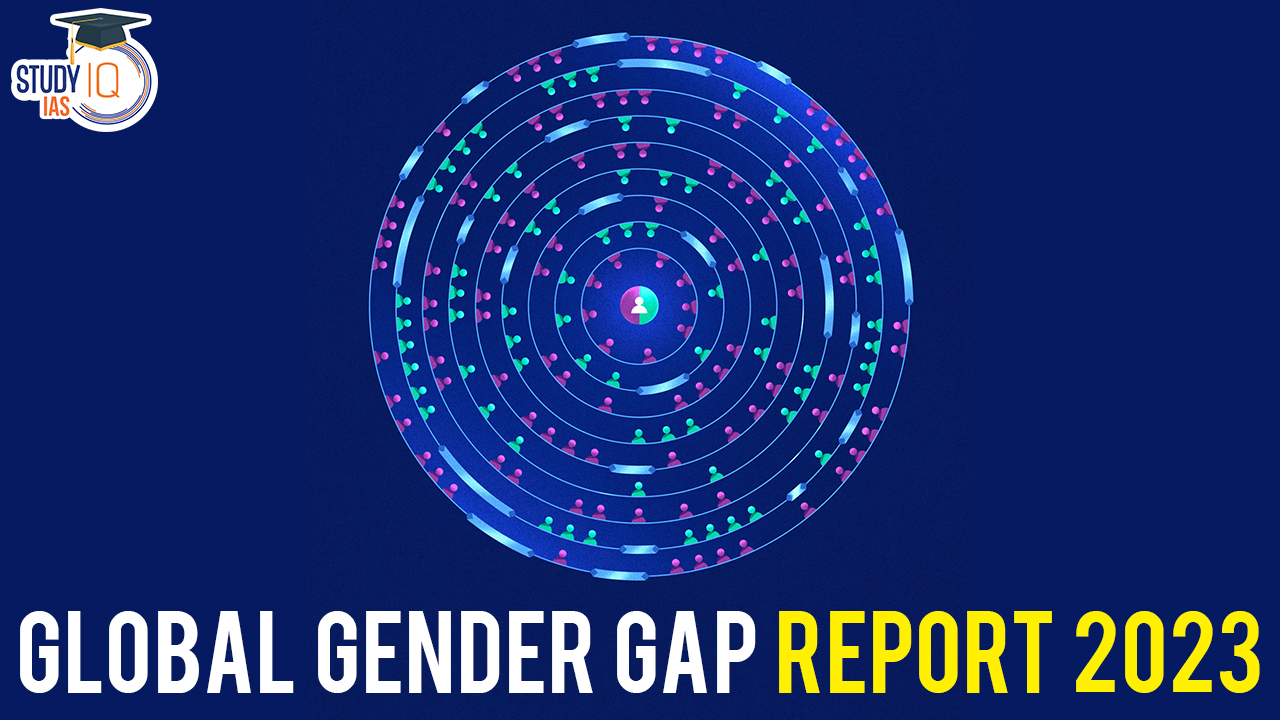Table of Contents
Context: India has moved up eight positions to rank 127 out of 146 countries in terms of gender parity in the Gender Gap Report for 2023.
About the Global Gender Gap Report 2023
- It is an annual publication by the World Economic Forum (WEF) that measures and analyzes gender disparities in various areas of life across countries.
- It provides a comprehensive assessment of gender gaps in four key areas:
- Economic participation and opportunity,
- Educational attainment,
- Health and survival, and
- Political empowerment.
- The report uses a set of indicators to measure gender equality, such as labor force participation rates, wage equality, educational enrollment rates, literacy rates, life expectancy, and political representation.
- These indicators are then used to calculate the Global Gender Gap Index, which quantifies the magnitude of gender-based disparities on a scale from 0 to 1, with 1 representing complete gender equality.
Key Findings of The Report for The World
- Global Gender Gap:
- The global gender gap in 2023 across 146 countries is 68.4% closed, indicating that there is still a significant gender gap worldwide.
- The overall score improved by 0.3 percentage points compared to the previous year.
- Top-performing countries:
- No country has achieved full gender parity yet.
- The top nine countries that have closed at least 80% of their gender gap are Iceland, Norway, Finland, New Zealand, Sweden, Germany, Nicaragua, Namibia, and Lithuania.
- Iceland has ranked first for the 14th consecutive year, having closed over 90% of its gender gap.
- Regional disparities:
- Europe surpasses North America and ranks first among the eight geographic regions, with a gender parity score of 76.3%.
- The Middle East and North Africa region remains the furthest from parity, with a score of 62.6%.
- Labor market disparities:
- Women’s participation in the labor market has increased slightly, but gaps still exist.
- The global labor-force participation rate parity improved from 63% to 64% between 2022 and 2023.
- However, women continue to face higher unemployment rates than men, and many women work in substandard conditions, particularly in the informal economy.
- Workforce representation:
- Women are underrepresented in leadership positions across industries.
- While women account for 41.9% of the global workforce, their representation in senior leadership positions is only 32.2%.
- Different industries exhibit varying levels of gender representation in leadership roles, with construction, financial services, and real estate having the lowest representation.
- Gender gaps in STEM:
- Women remain significantly underrepresented in science, technology, engineering, and mathematics (STEM) occupations.
- Although the percentage of female STEM graduates entering the workforce has increased, the retention of women in STEM careers remains a challenge.
- In the field of artificial intelligence (AI), women’s representation has progressed slowly, with approximately 30% of AI workers being women.
- Gender gaps in future skills:
- Online learning platforms offer opportunities for skill development, but there are gender gaps in access and enrollment.
- Disparities exist across various skill categories, with less than 50% parity in technology skills and AI. The gender gaps tend to widen as proficiency levels increase.
- Gender gaps in political leadership:
- The report noted that while there has been progress in increasing the number of women in political leadership roles globally, significant gender gaps still exist.
- The report mentions that as of December 2022, approximately 27.9% of the global population live in countries with a female head of state.
- The report also highlights a steady increase in the representation of women in parliaments globally, with the percentage of female parliament members rising from 18.7% in 2013 to 22.9% in 2022.
Key Findings of The Report for India
- India was ranked 127 among 146 countries in gender parity — up eight places from last year’s place.
- India had closed 64.3% of the overall gender gap, the report said.
- India’s Neighbours: The index ranked Pakistan at 142, Bangladesh at 59, China at 107, Nepal at 116, Sri Lanka at 115 and Bhutan at 103.
- Area wise performance:
- The report underlined that India had reached only 36.7% parity in economic participation and opportunity.
- The country had attained parity in enrolment across all levels of education, it said.
- In India, while there had been an uptick in parity in wages and income, the share of women in senior positions and technical roles had dropped slightly since the last edition, the report said.
- On political empowerment, India has registered 25.3% parity, with women making up 15.1% of MPs.
- Of the 117 countries with available data since 2017, 18 — including Bolivia (50.4%), India (44.4%) and France (42.3%) — have achieved women’s representation of over 40% in local governance.


 The Hindu Newspaper Analysis 6 October 2...
The Hindu Newspaper Analysis 6 October 2...
 The Hindu Newspaper Analysis 30 Septembe...
The Hindu Newspaper Analysis 30 Septembe...
 The Hindu Newspaper Analysis 27 Septembe...
The Hindu Newspaper Analysis 27 Septembe...





















